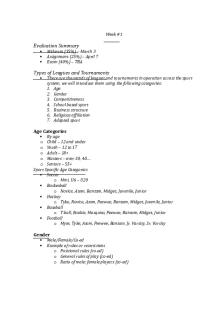Week 1 - Types of leagues and tournaments (age, gender, competitiveness, etc.) PDF

| Title | Week 1 - Types of leagues and tournaments (age, gender, competitiveness, etc.) |
|---|---|
| Course | League and Tournament |
| Institution | Humber College |
| Pages | 3 |
| File Size | 72.2 KB |
| File Type | |
| Total Downloads | 52 |
| Total Views | 135 |
Summary
Types of leagues and tournaments (age, gender, competitiveness, etc.)...
Description
Week #1
Evaluation Summary
Midterm (35%) – March 3 Assignment (25%) – April 7 Exam (40%) – TBA
Types of Leagues and Tournaments
There are thousands of leagues and tournaments in operation across the sport system, we will introduce them using the following categories: 1. Age 2. Gender 3. Competitiveness 4. School based sport 5. Business structure 6. Religious affiliation 7. Adapted sport
Age Categories By age o Child – 12 and under o Youth – 12 to 17 o Adult – 18+ o Masters – over 30, 40…. o Seniors – 55+ Sport Specific Age Categories Soccer o Mini, U6 – U20 Basketball o Novice, Atom, Bantam, Midget, Juvenile, Junior Hockey o Tyke, Novice, Atom, Peewee, Bantam, Midget, Juvenile, Junior Baseball o T-ball, Rookie, Mosquito, Peewee, Bantam, Midget, Junior Football o Myte, Tyke, Atom, Peewee, Bantam, Jr. Varsity, Sr. Varsity
Gender
Male/Female/Co-ed Example of rules or restrictions o Positional rules (co-ed) o General rules of play (co-ed) o Ratio of male: female players (co-ed)
Degree of Competiveness (Recreational Sport)
Recreational leagues/tournaments Follow a common philosophy o Participant driven approach – where all can receive benefit of equal participation o House league level o Includes adult recreational (some levels) o Non committal
Degree of Competiveness (Competitive Sport) While all sport can involve competition in its purest form (team 1 vs. team 2) competitive sport has other characteristics, resulting in more complex issues 1. Greater frequency (3-6 days/week) 2. Greater intensity (investing more energy, money, commitment, demonstrating a higher skill level) 3. Greater duration (across seasons including preparation) 4. Goal driven – winning vs. losing, performance measurement of wins/losses and advancing Examples: Various levels of formal structure, community/minor sports clubs o Select, Rep: A, AA, AAA o Playoffs can involve a few stages League Championships Ontario League Championship Provincial Championship o Single A – Quad A o Junior varsity, varsity o Elite and professional
School Based Competition Intramural o All members of school community o Increase school spirit and participation Extramural o Represent school community in tournaments Varsity o Represent school in highest level of competition, through league play and championships School Based Elementary o Junior, intermediate High School o Midget, junior, senior Collegiate o Freshman, sophomore, junior, senior
Various competitive stages o League championships o Regional championships o Provincial championships
Business Structure
Profit o Ownership based o Private enterprise o Profit is prime motive o Various levels Not for Profit o Sport associations o Membership based o Non profit purposes o Surplus goes back into club/organization o Affiliation with PSO (usually)
Religious Affiliation
Examples: o Barrie Christian Hockey League o Salvation Army Christian Junior Hockey League o B’nai Brith Basketball League
Adapted Sport
Ontario Cerebral Palsy Sports Ontario Wheelchair Sports
Sport Organizations in the Adapted Sport Arena
Special Olympics Canada o Enriching the lives of Canadians with intellectual disability through sport Canadian Paralympic Committee o Canadians with physical disability can receive the empowerment and confidence that comes from sport...
Similar Free PDFs

Week 6 - Task - Types of stories
- 4 Pages

Age of man - Age of Man
- 3 Pages

Week 6 - Task - Types of stories
- 4 Pages

Gender and Society module 1
- 5 Pages

Types of groups and leadership
- 13 Pages

Timeline OF Information AGE 1 1
- 5 Pages
Popular Institutions
- Tinajero National High School - Annex
- Politeknik Caltex Riau
- Yokohama City University
- SGT University
- University of Al-Qadisiyah
- Divine Word College of Vigan
- Techniek College Rotterdam
- Universidade de Santiago
- Universiti Teknologi MARA Cawangan Johor Kampus Pasir Gudang
- Poltekkes Kemenkes Yogyakarta
- Baguio City National High School
- Colegio san marcos
- preparatoria uno
- Centro de Bachillerato Tecnológico Industrial y de Servicios No. 107
- Dalian Maritime University
- Quang Trung Secondary School
- Colegio Tecnológico en Informática
- Corporación Regional de Educación Superior
- Grupo CEDVA
- Dar Al Uloom University
- Centro de Estudios Preuniversitarios de la Universidad Nacional de Ingeniería
- 上智大学
- Aakash International School, Nuna Majara
- San Felipe Neri Catholic School
- Kang Chiao International School - New Taipei City
- Misamis Occidental National High School
- Institución Educativa Escuela Normal Juan Ladrilleros
- Kolehiyo ng Pantukan
- Batanes State College
- Instituto Continental
- Sekolah Menengah Kejuruan Kesehatan Kaltara (Tarakan)
- Colegio de La Inmaculada Concepcion - Cebu









